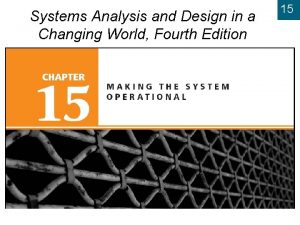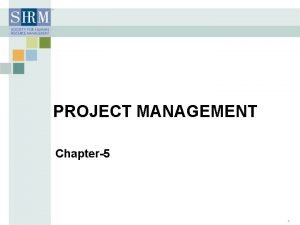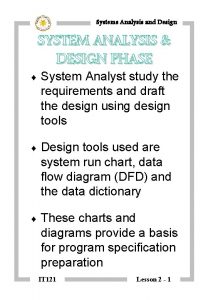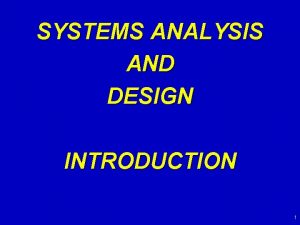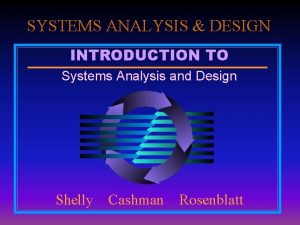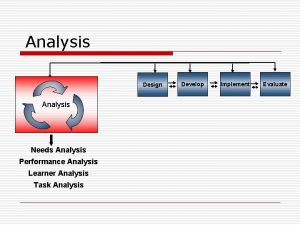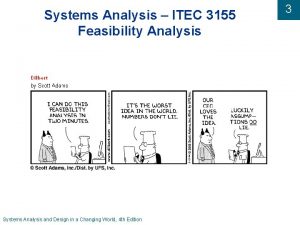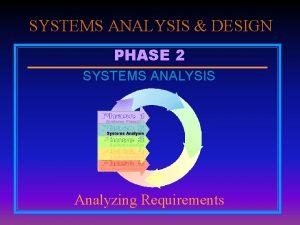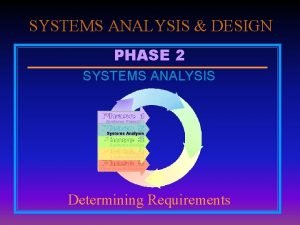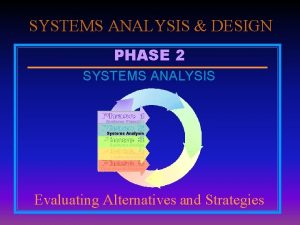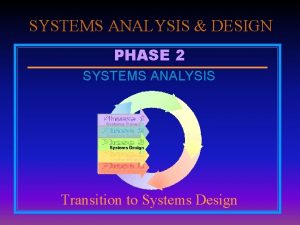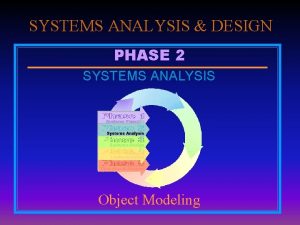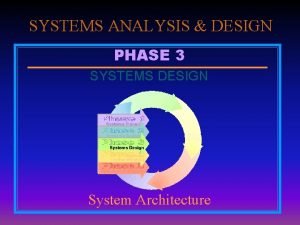Project Management Systems Analysis and Design 7 e


























- Slides: 26

Project Management Systems Analysis and Design, 7 e Kendall & Kendall © 2008 Pearson Prentice Hall CH#3

Learning Objectives • Understand how projects are initiated and selected • Define a business problem and determine the feasibility of a proposed project • Plan a project by identifying activities and scheduling them • Understand how an alternative approach called agile development balances objectives to manage the analysis and design process • Manage team members and analysis and design activities so the project objectives are met while the project remains on schedule Kendall & Kendall 3 -2

Project Management Fundamentals • • • Project initiation Determining project feasibility Activity planning and control Project scheduling Managing systems analysis team members Kendall & Kendall 3 -3

Project Initiation • Problems in the organization • Problems that lend themselves to systems solutions • Opportunities for improvement • Caused through upgrading, altering, or installing new systems Kendall & Kendall 3 -4

Figure 3. 1 Checking output, observing employee behavior, and listening to feedback are all ways to help the analyst pinpoint systems problems and opportunities Kendall & Kendall 3 -5

Problem Definition • Problem statement • Paragraph or two stating the problem or opportunity • Issues • Independent pieces pertaining to the problem or opportunity • Objectives • Goals that match the issues point-by-point • Requirements • The things that must be accomplished along with the possible solutions, and constraints, that limit the development of the system Kendall & Kendall 3 -6

Problem Definition Steps • Find a number of points that may be included in one issue • State the objective • Determine the relative importance of the issues or objectives • Identify which objectives are most critical Kendall & Kendall 3 -7

Selection Of Projects • Backing from management • Appropriate timing of project commitment • Possibility of improving attainment of organizational goals • Practical in terms of resources for the system analyst and organization • Worthwhile project compared with other ways the organization could invest resources Kendall & Kendall 3 -8

Determining Feasibility • Defining objectives • Determining resources • Operationally • Technically • Economically Kendall & Kendall 3 -9

Defining Objectives Many possible objectives exist including: • • Kendall & Kendall Speeding up a process Streamlining a process Combining processes Reducing errors in input Reducing redundant storage Reducing redundant output Improving system and subsystem integration 3 -10

Feasibility Impact Grid (FIG) • A feasibility impact grid (FIG) is used to assess the impact of any improvements to the existing system • It can increase awareness of the impacts made on the achievement of corporate objectives Kendall & Kendall 3 -11

Technical Feasibility • Can current technical resources be upgraded or added to in a manner that fulfills the request under consideration • If not, is there technology in existence that meets the specifications Kendall & Kendall 3 -12

Economic Feasibility • Economic feasibility determines whether value of the investment exceeds the time and cost • Includes: • • • Kendall & Kendall Analyst and analyst team time Business employee time Hardware Software development 3 -13

Operational Feasibility • Operational feasibility determines if the human resources are available to operate the system once it has been installed • Users that do not want a new system may prevent it from becoming operationally feasible Kendall & Kendall 3 -14

Activity Planning And Control • Planning includes: • Selecting a systems analysis team • Estimating time required to complete each task • Scheduling the project • Control includes: • Comparing the plan for the project with its actual evolution • Taking appropriate action to expedite or reschedule activities Kendall & Kendall 3 -15

Estimating Time • Project is broken down into phases • Further project is broken down into tasks or activities • Finally project is broken down into steps or even smaller units • Time is estimated for each task or activity • Most likely, pessimistic, and optimistic estimates for time may be used Kendall & Kendall 3 -16

Figure 3. 6 Beginning to plan a project by breaking it into three major activities Kendall & Kendall 3 -17

Project Scheduling • Gantt Charts • Simple • Lends itself to end user communication • Drawn to scale • PERT diagrams • Useful when activities can be done in parallel Kendall & Kendall 3 -18

Figure 3. 12 A completed PERT diagram for the analysis phase of a systems project Kendall & Kendall 3 -19

PERT Diagram Advantages • Easy identification of the order of precedence • Easy identification of the critical path and thus critical activities • Easy determination of slack time Kendall & Kendall 3 -20

Function Point Analysis • Count components • Rate each component’s complexity • Assign complexity numbers • Arrive at a subtotal • Multiply by adjustment factor Kendall & Kendall 3 -21

Managing Analysis and Design Activities • Team management • • Kendall & Kendall Assembling a team Team communication strategies Project productivity goals Team member motivation 3 -22

Assembling a Team • • • Shared value of team work Good work ethic Honesty Competency Readiness to take on leadership based on expertise • Motivation • Enthusiasm for the project • Trust of teammates Kendall & Kendall 3 -23

Communication Strategies • Teams often have two leaders: • One who leads members to accomplish tasks • One concerned with social relationships • The systems analyst must manage: • Team members • Their activities • Their time and resources Kendall & Kendall 3 -24

Project Productivity Goals and Motivation • Successful projects require that reasonable productivity goals for tangible outputs and process activities be set • Goal-setting helps to motivate team members Kendall & Kendall 3 -25

Project Failures • Project failures may be prevented by: • Training • Experience • Learning why other projects have failed • Project charter • Describes in a written document what the expected results of the systems project are and the time frame for delivery Kendall & Kendall 3 -26
 Project management in system analysis and design
Project management in system analysis and design It analysis design and project management
It analysis design and project management Traditional vs modern project management
Traditional vs modern project management Kendall & kendall systems analysis and design
Kendall & kendall systems analysis and design Systems analysis and design in an age of options
Systems analysis and design in an age of options System analysis and design
System analysis and design Systems analysis and design in a changing world
Systems analysis and design in a changing world Systems analysis and design in a changing world
Systems analysis and design in a changing world Systems analysis and design dennis
Systems analysis and design dennis System analysis and design
System analysis and design Major tools of ssadm
Major tools of ssadm Modern systems analysis and design
Modern systems analysis and design Modern systems analysis and design
Modern systems analysis and design Kendall and kendall system analysis and design
Kendall and kendall system analysis and design Systems analysis and design alan dennis
Systems analysis and design alan dennis Systems analysis and design alan dennis
Systems analysis and design alan dennis Systems analysis and design alan dennis
Systems analysis and design alan dennis Systems analysis and design alan dennis
Systems analysis and design alan dennis Systems analysis and design alan dennis
Systems analysis and design alan dennis Systems analysis and design alan dennis
Systems analysis and design alan dennis Systems analysis and design alan dennis
Systems analysis and design alan dennis Ssadm
Ssadm Radar systems analysis and design using matlab
Radar systems analysis and design using matlab Object-oriented systems analysis and design using uml
Object-oriented systems analysis and design using uml A modern approach to systems analysis and design
A modern approach to systems analysis and design Kendall and kendall system analysis and design
Kendall and kendall system analysis and design Systems analysis and design in a changing world
Systems analysis and design in a changing world


























